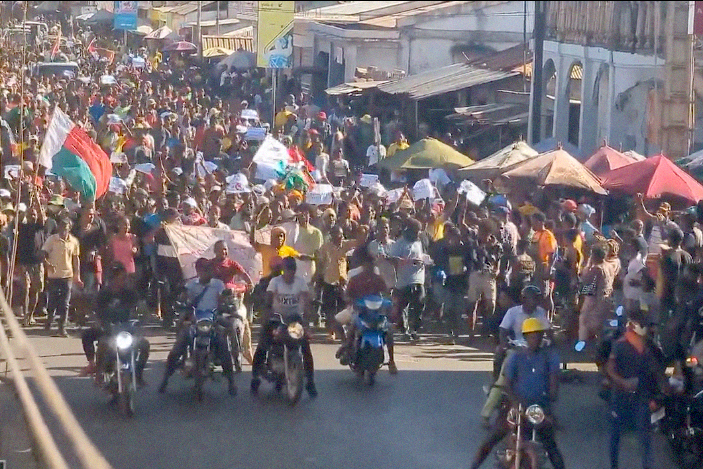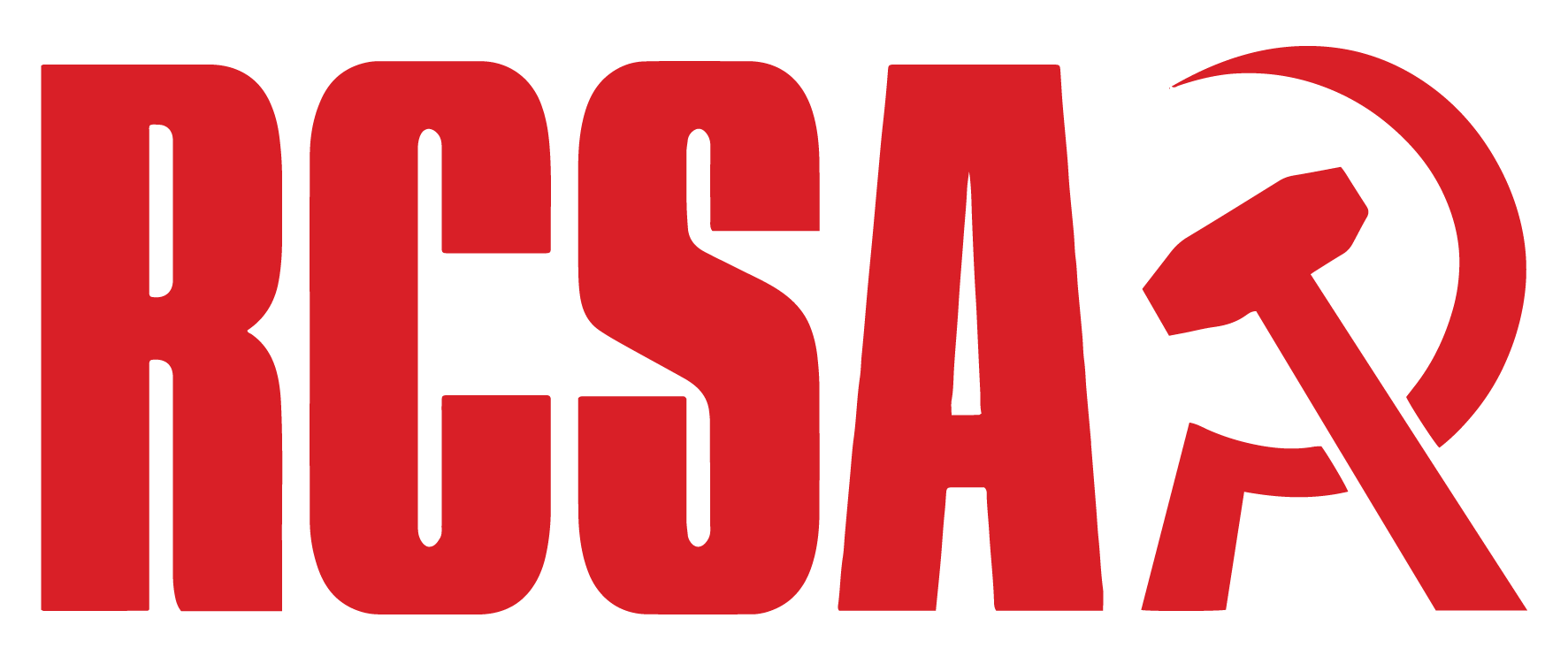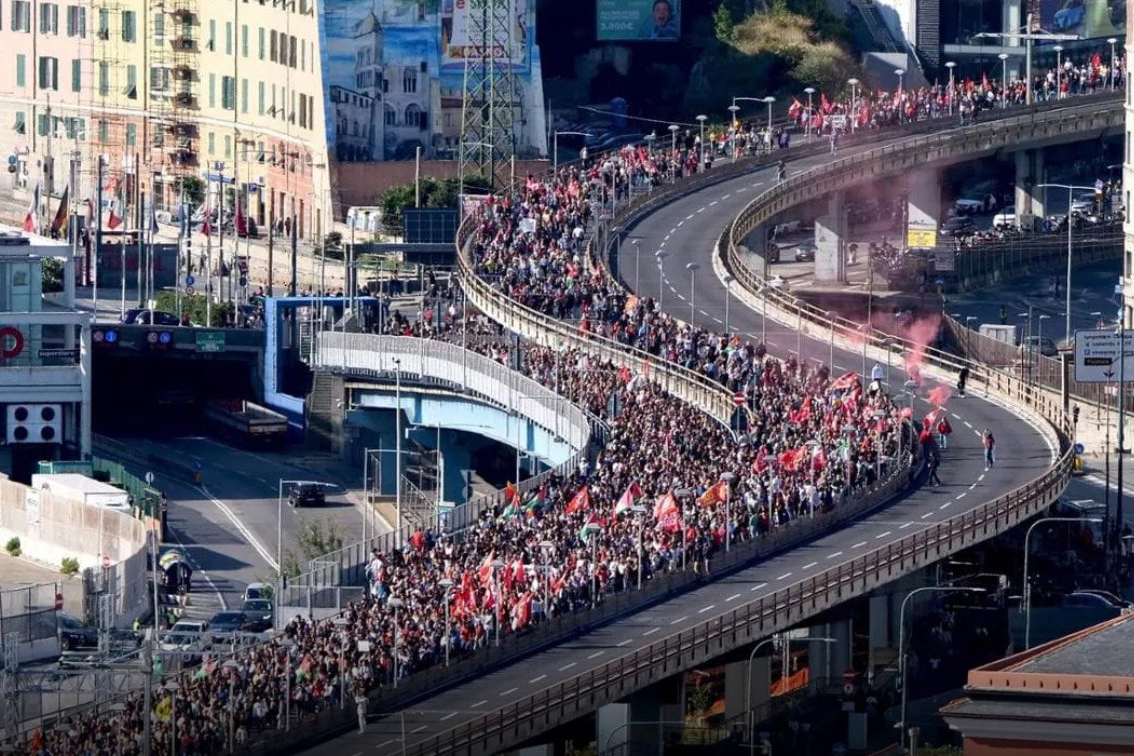[Jorge Martín, 13 October 2025 – originally published on marxist.com]
Events have developed at lightning speed over the weekend in Madagascar. The mass youth movement, which started on 25 September, has now overthrown the old regime. A section of the army refused to continue carrying out repression against the masses and mutinied. The president had to be airlifted by the French military on Sunday, 12 October.
The spark for the movement was the constant electricity cut-offs, which make daily life very difficult. But that was just the most striking symptom of a deep malaise against corruption, the obscene contrast between the wealth of those at the top (including prominent businessmen close to the president) and the dire conditions of the masses on an island where 79 percent live under the poverty line.
From protest to uprising
What started as a peaceful protest movement by the student youth, partly inspired by the GenZ revolutions in Indonesia and Nepal, became a national uprising after the regime of President Rajoelina used brutal repression against the demonstrators, leaving at least 25 dead. As repression did not cow the youth, the regime attempted concessions, dismissing the government and then appointing a new prime minister. It was too little too late. The aim of the movement had become the overthrow of the whole bloody regime.
A test of force between the masses and the regime took place on 30 September, when the youth managed to break through police lines in the capital and reach the central May 13 square. The regime was suspended in mid-air, but resorted again to repression over the following days.
The clashes between the students and the hated forces of the gendarmerie intensified. The GenZ Madagascar movement made a call for a general strike and sections of the organised trade union movement started to join in. This included junior doctors, who brought their own demands about conditions, civil servants, the workers at the JIMAR water and electricity company, and also the prison wardens, who announced they would refuse to take into custody any more of the arrested protesters.
It was the growing pressure of the mass movement and the president’s stubbornness in remaining in power – even by attempting to appoint a new prime minister – which finally opened up a crack in the army.
Army defects
On 2 October, there were rumours of clashes inside some military barracks as a mutinous mood developed. Tear gas canisters were used. It was a very confused situation, which apparently led to the arrest of ten soldiers from the CAPSAT unit, the Army Personnel and Services Administration Corps, based in Soanierana, near the capital.
On 10 October, in the northern city of Antsiranana, one of the places where the movement has been strongest, army soldiers, instead of blocking the path of the demonstrators, opened the way and escorted them down to the city centre. This sent a very clear message, openly defying the president’s orders.
President Rajoelina, now suspended in mid-air, made a number of promises, including power generators for the universities. He asked for a truce of one year in which he committed himself to solving the problems raised by the movement. It was clearly too late. The masses were in no mood to compromise. They wanted the whole regime out.
On 11 October, finally the dam breached. CAPSAT soldiers, led by their commanding officers, made a public announcement that they would no longer be used to repress the protests, a move of open insubordination.
“Our children are suffering, we are not here to kill and beat them. We are experiencing the same suffering. We must support them. Let us not allow ourselves to be manipulated by money or position.”
Their statement reveals two very significant questions: soldiers are drawn from working-class families and it reached a point when they refused to be used against their brothers and sisters (and children). They also suffer from the same conditions which affect working people in general (poverty, electricity cut-offs, etc).
In their statement, CAPSAT made an appeal to other units of the army, as well as to the police and the gendarmerie, to follow their lead. They called on the population to join in the defence of their barracks, appealed to the presidential guard to disobey orders and made a call to block the road to the airport in Antananarivo, in case the president attempted to flee. It was a full-blown call for a general insurrection.
President Rajoelina replied with a statement warning that a coup was underway, but there was little he could now do.
On the same day, CAPSAT soldiers, after having secured their installations, came out, arms in hand and led the protesters towards the May 13 square. The route to the square was blocked by armed soldiers from the gendarmerie and so ensued a short exchange of fire. The army was far superior and the gendarmerie officers were seen running away. A CAPSAT soldier, Fanomezantsoa Stephano Jacky, and two civilians, Safidy and Rivoniandry Riva Rakotomalala, were killed in the gunfight. Nevertheless, the masses, accompanied and protected by the rebellious soldiers, entered the square. It was the beginning of the end for the regime.
In the hours that followed, the CAPSAT unit moved quickly to consolidate its position. A meeting with the commanding officers of the gendarmerie assured their neutrality and no more clashes. At least one unit of the gendarmerie also went over to the side of the people. The National Gendarmes Intervention Force (FIGN), which is in charge of presidential protection, had come out in a public statement apologising to the masses for the use of repression and announcing that the whole of the gendarmerie should be put under their control.
Then, the final challenge came, when, in the early hours of Sunday 12 October, the CAPSAT officers declared that all military and police units should obey their orders. They appointed a new head of the armed forces, Général Démosthène Pikulas, the commanding officer at CAPSAT. Then the gendarmerie was put under the command of Brigade General Mamelison Mbina Nonos, from the FIGN. The rebellious army units were now in control of the armed forces.
On Monday, the Senate met and removed its president, the hated General ‘Bomba’ (Richard Ravalomanana), seen as the mastermind behind the brutal repression of the movement. It was a foregone conclusion. The power was no longer in the hands of the institutions, but in the hands of the rebellious army and the masses on the streets.
President Rajoelina flees!
It remained to be seen what President Rajoelina would do. There were rumours that he had already fled the country, but on Monday 12 October, an announcement on his official Facebook account said he would address the country that evening. It was a distraction maneuver, as it was revealed that he had already been airlifted out of the country the day before by a French military plane, first to La Reunion and then possibly to Dubai. The former colonial power still exercises enormous sway on the island’s politics and economy.
The deposed Prime Minister Christian Ntsay and businessman, and Mamy Ravatomanga, a close ally of the president, had already made their way off the island, in a private jet, to Mauritius.
What next? First of all, we must say clearly that the overthrow of Rajoelina is a victory for the Gen Z Madagascar movement. It was the courageous and relentless struggle of the youth, which then spread widely to sections of the working class and the population in general, which finally forced him out. The army would have never broken ranks had it not been for the tireless struggle of the masses of youth which, for nearly three weeks, remained on the streets and intensified their actions in the face of bloody repression.
The courage, resilience and steadfastness of the Malagasy masses in the face of brutal repression and with very little previous organisation is an example and an inspiration for the masses of workers and youth across the continent and worldwide.
How can the army rebellion be explained? On the one hand, it is clearly the result of the impact of the mass mobilisation on the rank-and-file soldiers and lower-ranking officers, which come from working-class families themselves and whose living conditions are close to those of working people. Every genuine revolution produces such splits in the state apparatus along class lines.
There is, however, another factor. Some of the commanding officers, who had already participated in a similar rebellion in 2009 during a previous mass movement, were moved by different considerations. They could see the regime going down and did not want to be dragged down with it. They thought a quick army rebellion would ensure that the whole institution would remain intact and be able to play a role in the transition of power after the removal of Rajoelina. What really motivates them is their own fate and the need to guarantee bourgeois institutional hand over.
What next for GenZ Madagascar?
The masses, of course, are jubilant, and received CAPSAT soldiers as heroes. But they should remain vigilant and show no trust in the commanding officers who have only switched sides at the last minute, motivated by their own self-preservation.
Already on Monday, some in the square commented how all sorts of political and public figures were making speeches on the stage, despite having played no role in the struggle. Rather, they were now trying to position themselves to become the beneficiaries of it.
“I’m frustrated and a little disappointed with what’s happening right now,” one protester told French news agency RFI. “I have the impression that young people have done all the work and now it’s the older ones who are there putting on a show, as usual. After all, it’s political, so young people haven’t necessarily been involved in politics. But what’s happening right now is a little disappointing. It feels a bit like political co-optation. We’d like to put someone in power, not someone who’s been there for a long time and for whom it’s easier to take their place. Our fight is far from over.”
The Gen Z Madagascar movement has taken massive strides forward and become much more organised in the course of the two-week struggle. District Struggle Coordination Committees (KMT) have been set up, and, in some neighbourhoods of the capital, embryonic vigilance patrols against looting have been created. However, the movement is probably not organised enough to withstand the enormous pressure for a return to ‘normal’ bourgeois politics.
As in Bangladesh last year and in Nepal a few weeks ago, there will now be enormous pressure for the formation of a new, provisional government, probably headed by some ‘independent’ figure that is not tainted or discredited like all bourgeois politicians.
In order to give it a semblance of legitimacy and placate the student youth, it is even possible that the movement will be consulted about the choice of president. Perhaps even some from their own ranks will be included. The new heads of the armed forces, from the rebellious units, will guarantee the whole process. This is more or less what happened after the 2009 mass movement, in a process which ended up with a ‘youthful figure’ ‘from outside politics’ taking over. His name? President Rajoelina.
However, the main question remains. None of the acute problems facing the masses can be resolved without challenging the capitalist system as a whole. The problem is not simply corruption. Corruption is a symptom of the rottenness of the capitalist system in a backward country dominated by imperialism. The movement raised the demand for the expropriation of the properties of Mamy Ravatomanga, one of the country’s wealthiest capitalists. It is not just him, but all of the capitalists who should be expropriated.
If the Malagasy masses had a revolutionary leadership armed with a clear programme to overthrow capitalism, they could now be celebrating a full victory for the revolution. Lacking that, they will most likely have to go through the same experience as the masses in Sri Lanka, Bangladesh, Nepal, etc.
The slogans of the day are:
- No confidence in bourgeois politicians, public figures and army generals – the masses of youth and workers should trust only their own forces.
- No transition dictated from up on high to another capitalist government so that nothing changes – but all power to the working people organised in democratic committees of struggle.
- For workers’ control of publicly-owned companies (chiefly JIMAR) and for the cancellation and reversal of all privatisation measures.
- Expropriate the ill-gotten gains of Rajoelina, Ravatomanga and their coterie.
- French imperialism, out.
- For a government of the working people to take control of the island’s resources so they can be used democratically to satisfy the needs of the many.



